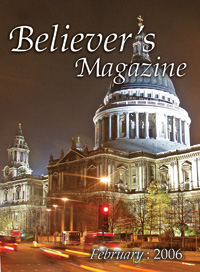Introductory
A distinctive feature of John’s Gospel is the repeated reference to the Lord’s miracles as "signs". The import of this will be highlighted in the later parts of this paper. At this point it will be sufficient to say that the account of the first miracle, in ch.2, is rounded off by the description "this beginning of his signs" (v.11, RV). At the end of the book (20.30-31) John comments, "Many other signs therefore did Jesus in the presence of the disciples…But these are written that ye may believe that Jesus is the Christ, the Son of God; and that believing ye may have life in his name" (RV). These two references to signs seem to act as a frame within which the sign evidences are depicted.
The signs were designed by the Lord to lead people to faith ("that ye may believe"). We shall see that those who witnessed the signs either responded in faith or else resented them. In each case, however, they were faced with evidence which demanded a verdict. In ch.6 the Lord accused people who crowded after Him, of seeking Him, "not because ye saw signs, but because ye ate of the loaves, and were filled" (v.26, RV). It seems likely that by "seeing the signs" He meant seeing the import, what was signified.
Let us, then, look at the evidence provided in the incidents and what impact the signs had on those present.
Water into Wine at Cana: Chapter 2
The scene was a wedding, normally an occasion for joy and celebration. In this case the possibly seven-day celebration looked as if it would be ruined by a shortage of wine. Mary mentioned the shortage to Jesus. He made it clear to her (v.4) that what He was going to do would not be a special favour to her because she was His mother. He also symbolically made it clear that true joy would not spring from the rituals of Judaism - the waterpots for cleansing ceremonies.
We should examine carefully how these large waterpots fit into the story. These seem to have held between 20 and 30 gallons (approx 90-135 litres) each. When the Lord said, "Draw out now", He used a word for "draw" which normally refers to drawing water from a well rather than taking it out of a container. We are therefore justified in believing that He told them to draw water from the well. By the time this water drawn directly from the well was presented to the "ruler of the feast", it had been turned into wine by the power of the Creator. Judaistic cleansing rites were powerless to give true joy; only the Christ could do that. The waterpots were static, not dynamic.
But how did the ruler of the feast know that this was really wine? He tasted it. It had not mystically, symbolically become wine; it was, literally, really good wine. It is significant that John makes the point that the ruler of the feast did not know the source of this good wine; he sampled it "blind", as tasters would say. The men who brought it knew its source, because they drew it. The ruler had not expected the best wine at this stage, but he discovered that it was good wine because he tasted it.
What was the result? Jesus "manifested forth his glory; and his disciples believed on him" (v.11). The result of the sign, as a sign, was positive.
The Nobleman’s Son: Chapter 4
This story, beginning at 4.46, is explicitly linked to the first sign miracle: this likewise was performed at Cana. The Lord anticipated the unbelief of the bystanders by declaring (v.48), "Except ye see signs and wonders, ye will not believe". We note the addition of "wonders" here, its only occurrence in this Gospel. Wonders they could see: signs they blindly misunderstood.
The nobleman "believed", as did his whole household. They had, between them, the full evidence. He knew at what time the Lord spoke the word of power; his household knew at what time the son was healed. The evidence was watertight, if people would observe and think with open minds. We are not told that others who were present to hear the Lord’s words bothered to enquire if they were effective, or mere words.
"This", John tells us, "is again the second sign that Jesus did, having come out of Judaea into Galilee" (v.54, RV).
The Cripple at the Pool: Chapter 5
On this occasion the Lord went up to a festival at Jerusalem. While He was there He saw a man lying helpless by the Bethesda pool. The man’s disablement had lasted 38 years. Understandably, he had almost given up hope. He had no man to give him the help he needed. Knowing that he had been in this condition for a long time the Lord asked him, "Do you want to get well?"; that is the literal translation of the question. The man’s response was not a direct answer to the question, but it amounted to an admission of his utter helplessness. Jesus responded to this admission by telling him to rise, take up his bedroll, and walk.
Two factors in the situation need to be stressed. First, Jesus knew that He was being watched in Jerusalem, for in John’s Gospel there is a constant reference to the hostility of "the Jews"; that is, the people of Jerusalem and Judaea. Second, He was well aware that this was the sabbath and that there would be opportunity for His enemies to challenge Him.
In the debate which follows He uses the incident to show that His works mirror those of the Father: "My Father worketh hitherto, and I work" (v.17). This use of "my" implies the uniqueness of His link with the Father. They say He "called God his own Father, making himself equal with God" (v.18, RV). The good work which He did, while it is not expressly called a sign in this chapter, serves as His basis for expounding how He stands in relation to God, as God’s eternal Son. His unceasing, gracious activity mirrors that of His Father.
This is an example of a sign which drew forth hatred and hostility because it declared His unique Sonship. The rest of the chapter is devoted to the debate; then, almost immediately, we read: "And a great multitude followed him, because they beheld the signs which he did on them that were sick" (6.2, RV). Open hostility was evidently not the only reaction to this sign.
The Storm on Galilee: Chapter 6
The Lord’s actions in this episode are not called a sign. If we expect seven signs in this book, which seems a reasonable expectation, we may interpret this as a sign. Against this we note that the rest of this chapter is taken up with the feeding of the 5,000, with no teaching based on the storm incident. It seems likely, therefore, that this is not to be taken as a sign in the structure of the Gospel of John.
The view taken in this paper is that the seventh sign is the Lord’s resurrection, and we shall see that ch.20 is full of language to be expected when sign-evidence is present. But, more of that hereafter!
To be continued.









